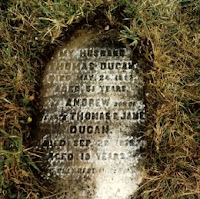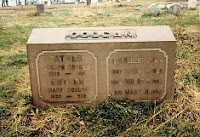Hopewell Cemetery pg 1: "Hopewell Cemetery Contributed by Susan Patton HopewellCemetery is located five miles west of Pinckneyville, Illinois, on Highway 154, then South on small side road, to a hill covered with stately trees. A sign is posted along the highway. The first burial date was before 1830. Some of the area's earliest settlers are buried here. The Hopewell Cemetery Association was organized June 2, 1970, to maintain and preserve this cemetery. Hopewell Presbyterian Church, which no longer stands, bordered the east side of the cemetery. The Church was built in 1831. By 1885, the parishioners had increased and a new church was built , called Four Mile Presbyterian Church, leaving the old one abandoned." For the legend that goes with the above picture visit the web site by clicking on the above link.
For the legend that goes with the above picture visit the web site by clicking on the above link.
While these two stones do not appear to be of relatives, I took photographs to be on the safe side. Who knows, somewhere down the line I may be glad I did. They both are flat in the ground in Section 10.
 My Husband, Thomas Dugan, Died May 24, 18??, Aged 51 Years.
My Husband, Thomas Dugan, Died May 24, 18??, Aged 51 Years.
Andrew, Son of the late Thomas & Jane Dugan. Died Sep. 22, 1876, Aged 10 Years.
May They Rest In Peace.
 In Memory of My Daughter Eliza Goodchild, Died Aug. 18, ___7, Aged 26 Years.
In Memory of My Daughter Eliza Goodchild, Died Aug. 18, ___7, Aged 26 Years.
Also My Daughter Ida Goodchild, Died Feb. 7, 1890, Aged 4 Years & 4 Mos.
Also Annie Dugan, Died Feb. 25, 1889, Aged 21 Years
Children of Jane and the late Thomas Dugan. May They Rest In Peace.
In order to do cemetery research you will first need to learn where your ancestor is buried. Here are a few ways to do that:
Locate death records and/or obituaries. They nearly always mention the cemetery.
Ask family members if they have any funeral, mass or prayer cards. Also ask if they know of family burial locations.
Funeral homes can be helpful in locating cemetery records. The funeral home is often mentioned in obituaries and death notices. Also, funeral directors will have knowledge of the cemeteries in their area.Check with the church your ancestors attended. Often a record of the death and burial is kept by the church. Also, some churches have attached cemeteries and will have records of the burials there. If you don't know the church, check a map of the area where your ancestor lived and see what churches are near where they lived.
Don't forget to check with the local genealogical or historical society. Quite often they have compiled cemetery indexes.
On-line sources can be very helpful and there are quite a few. Check out Cindi's List at http://www.cyndislist.com/deaths.htm for a varied list.
 Way back in 1987, before there was so much concern with privacy and records were more easy to obtain, I had contacted Mt. Moriah Cemetery to get any information they had on Dougan burials. For a fee they did the research and sent me a wonderful listing that included the name, age at death, date interred and grave site. I doubt very much you would be able to do this today with all the privacy restrictions.
Way back in 1987, before there was so much concern with privacy and records were more easy to obtain, I had contacted Mt. Moriah Cemetery to get any information they had on Dougan burials. For a fee they did the research and sent me a wonderful listing that included the name, age at death, date interred and grave site. I doubt very much you would be able to do this today with all the privacy restrictions.
This photo is a copy of the map that was sent along with the information. I was easily able to find each grave I was interested in.
Genealogy.com: Tips for Photographing Gravestones:
Cleaning the StoneCleaning a cemetery stone is a controversial topic. The first rule of conservation and preservation is to cause no damage. Unfortunately, by using household cleaners, chalk and shaving cream to enhance the lettering you may injure the surface in ways that are not readily apparent. Caution should be used before you destroy what you set out to preserve.
Over the centuries several different types of stones have been used to create gravestones. Some of the stones are quite porous and fragile, while others are resistant to damage. Be careful when attempting to improve the readability of the inscription. Types of stone:
- Prior to the Nineteenth century: Sandstone or slate
- Nineteenth Century: Marble and gray granite
- Late nineteenth century to the present: Polished granite or marble
There are a few things that you can do that will not cause injury.
- A soft brush or natural sponge and water will help you remove surface soil. Gentle brushing should remove surface dirt and bird droppings. Power washing should not be used; water should flow over the stone or be delicately sprayed onto the surface. Never use hard objects or stiff brushes to clean the stone. Removing lichens with sharp objects may inadvertently destroy the surface.
- Not all cemeteries are regularly maintained. By trimming tall weeds around the base of the stone and cutting the grass you may discover epitaphs hidden under the overgrowth.
 For the legend that goes with the above picture visit the web site by clicking on the above link.
For the legend that goes with the above picture visit the web site by clicking on the above link.










